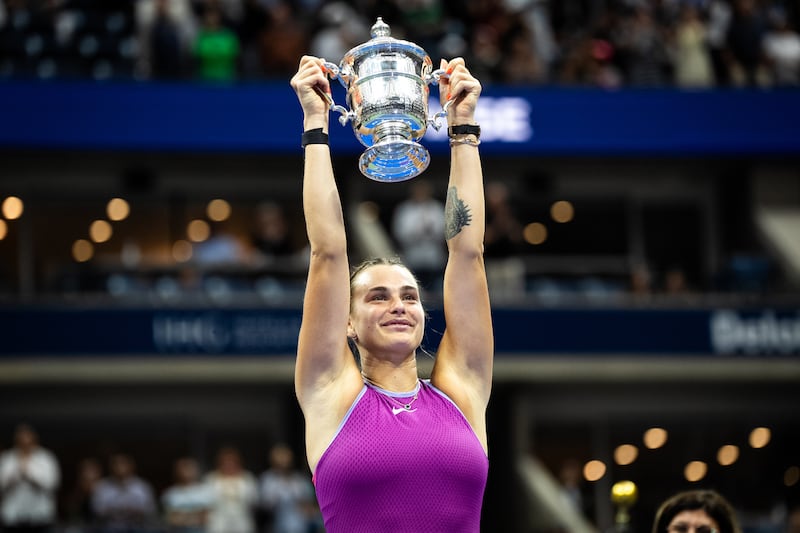As the magnificent opening set of the US Open final between Aryna Sabalenka and Jessica Pegula reached its breathless climax on Saturday evening in New York, the supreme quality of their shotmaking belied the suffocating tension on both sides of the net. After failing to serve out the set against a resolute Pegula, Sabalenka desperately tried to avoid the familiar sensation of collapsing under pressure in a significant grand slam match.
The solution that Sabalenka found was reflective of the extensive work it has taken for her to become a champion. In the closing stages of the set, Sabalenka did not simply blast her way to victory – she also found joy with touch, net play and intelligence. In three of her last four winning points in the set, Sabalenka disrupted Pegula’s excellent defensive efforts with deft volleying and intelligent drop shots.
While leading 6-5 and at deuce on Pegula’s serve, Sabalenka pulled Pegula off the baseline with a sweet backhand drop shot before lasering a forehand passing shot winner beyond her helpless opponent. Then, after Pegula had willed herself to game point, Sabalenka snuck into the net behind a deep, piercing backhand before executing a delicate forehand drop-volley winner. On her fifth set point, Sabalenka finally sealed the opening set with another perfectly weighted backhand drop shot.
Sabalenka has spent almost her entire career winning matches solely through her brutal shotmaking abilities. But she has added another dimension to her game by becoming increasingly comfortable at the net and keeping her opponents guessing with smart, well executed drop shots. While some tennis players prioritise working on their strengths, the variation that Sabalenka has added to her game underlines her determination to leave no stone unturned in pursuit of her growth.
READ MORE
“I’m really glad that I’m brave enough to use these tools in those key moments,” Sabalenka said. “I think that’s really important to always improve yourself. I feel I put even more pressure on the opponents when they see I’m not only a hard hitter, I can also play with some touch. So we always work on those assets of my game.”
That growth has come in so many other forms. Sabalenka has never shied away from discussing how her tendency to lose herself in her emotions has proven such a significant obstacle to her success. Along her journey, Sabalenka sought out a sports psychologist to help her better understand her mental struggles and gain tools to manage them. One of the most important decisions in her development, though, was to actually stop seeing her sports psychologist. She felt it was up to her to put those tools into action in the heat of battle.
The composure and calmness Sabalenka generally displays on the court these days is a remarkable transformation from the player who once wore her heart on her sleeve at all times. Against Pegula, Sabalenka truly lost her composure only once after she double faulted at 5-5, deuce, in the opening set. She immediately responded with a blistering backhand winner to save the break point, the last time she trailed in the match. Otherwise, she remained calm enough to think clearly until the end in a tense, turbulent battle.

During the early months of the 2022 season, when her serve was so pitiful that she was repeatedly reduced to hitting underarm serves in the middle of her matches, Sabalenka’s coach, Anton Dubrov, admitted to Sabalenka that he could no longer help her and she needed to find another coach to help her fix her serve.
His resignation was rejected. Sabalenka believed that her issues were a result of her own fundamental problems and she needed to find a way past those issues herself. She and her team eventually concluded that her serve was too technically flawed and by the summer of that year they had sought out a biomechanics coach to alter her service motion. Sabalenka’s improved serving, and the clear confidence she has in that stroke even when it is not necessarily flowing perfectly, has been another pillar in her success.
With every significant obstacle that she has faced over the years, Sabalenka has held herself accountable and searched for solutions instead of counting on the possibility that her natural ball-striking talent would eventually guide her to success. It has been a fascinating evolution and it has catapulted her to immense success.
Her victory also leaves the WTA’s era-defining rivalry perfectly poised. Iga Swiatek, the French Open champion this year, remains the No 1 player by 2,000 points and she has been the more consistent player week after week on the gruelling tour, but Swiatek has significantly underachieved at the grand slam tournaments outside of Roland Garros. While she has actually won more titles on hard court than clay, Swiatek has still reached just two grand slam semi-finals away from the French Open in her career.
Between Sabalenka’s remarkable consistency at the grand slam tournaments and now her new distinction of winning two major titles in the season, it is clear that she leaves New York as the best player in the world, fractionally, and she will surely continue to solidify her standings in the tennis history books. — Guardian















